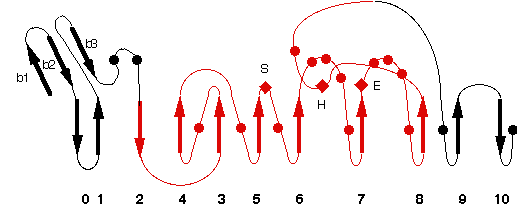3VKF
Name : Crystal Structure of Neurexin 1beta\/Neuroligin 1 complex
Revelation date : 01-Aug-2012
Family : Neuroligin
Gene_locus : ratno-1neur
PDB file : ESTHER: header of PDB entry RCSB: Full entry
Comment
Tanaka, H., Miyazaki, N., Nogi, T., Iwasaki, K., Takagi, J.
Ligand :
References (1)
| Title : Higher-order architecture of cell adhesion mediated by polymorphic synaptic adhesion molecules neurexin and neuroligin. - Tanaka_2012_Cell.Rep_2_101 |
| Author(s) : Tanaka H , Miyazaki N , Matoba K , Nogi T , Iwasaki K , Takagi J |
| Ref : Cell Rep , 2 :101 , 2012 |
| Abstract : Tanaka_2012_Cell.Rep_2_101 |
| ESTHER : Tanaka_2012_Cell.Rep_2_101 |
| PubMedSearch : Tanaka_2012_Cell.Rep_2_101 |
| PubMedID: 22840401 |
| Gene_locus related to this paper: ratno-1neur |
Representative scheme of Prolylcarboxypeptidase structure and an image from PDBsum server

